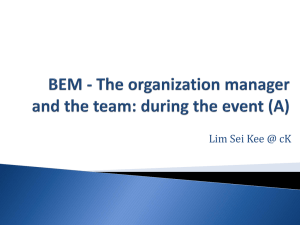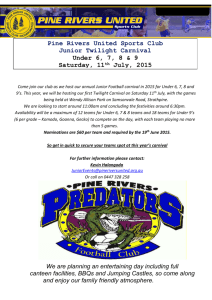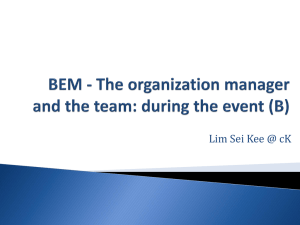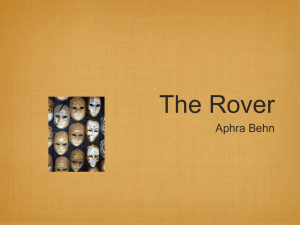CARNIVAL GAME RUBRIC (Steps 1 to 4)
advertisement
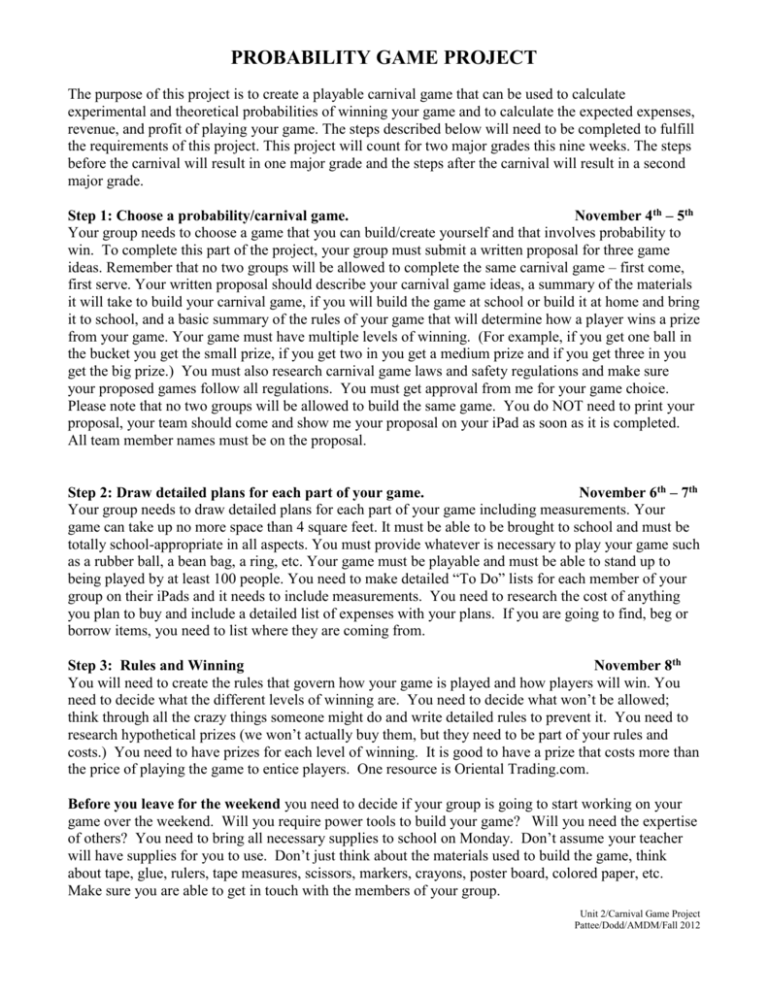
PROBABILITY GAME PROJECT The purpose of this project is to create a playable carnival game that can be used to calculate experimental and theoretical probabilities of winning your game and to calculate the expected expenses, revenue, and profit of playing your game. The steps described below will need to be completed to fulfill the requirements of this project. This project will count for two major grades this nine weeks. The steps before the carnival will result in one major grade and the steps after the carnival will result in a second major grade. Step 1: Choose a probability/carnival game. November 4th – 5th Your group needs to choose a game that you can build/create yourself and that involves probability to win. To complete this part of the project, your group must submit a written proposal for three game ideas. Remember that no two groups will be allowed to complete the same carnival game – first come, first serve. Your written proposal should describe your carnival game ideas, a summary of the materials it will take to build your carnival game, if you will build the game at school or build it at home and bring it to school, and a basic summary of the rules of your game that will determine how a player wins a prize from your game. Your game must have multiple levels of winning. (For example, if you get one ball in the bucket you get the small prize, if you get two in you get a medium prize and if you get three in you get the big prize.) You must also research carnival game laws and safety regulations and make sure your proposed games follow all regulations. You must get approval from me for your game choice. Please note that no two groups will be allowed to build the same game. You do NOT need to print your proposal, your team should come and show me your proposal on your iPad as soon as it is completed. All team member names must be on the proposal. Step 2: Draw detailed plans for each part of your game. November 6th – 7th Your group needs to draw detailed plans for each part of your game including measurements. Your game can take up no more space than 4 square feet. It must be able to be brought to school and must be totally school-appropriate in all aspects. You must provide whatever is necessary to play your game such as a rubber ball, a bean bag, a ring, etc. Your game must be playable and must be able to stand up to being played by at least 100 people. You need to make detailed “To Do” lists for each member of your group on their iPads and it needs to include measurements. You need to research the cost of anything you plan to buy and include a detailed list of expenses with your plans. If you are going to find, beg or borrow items, you need to list where they are coming from. Step 3: Rules and Winning November 8th You will need to create the rules that govern how your game is played and how players will win. You need to decide what the different levels of winning are. You need to decide what won’t be allowed; think through all the crazy things someone might do and write detailed rules to prevent it. You need to research hypothetical prizes (we won’t actually buy them, but they need to be part of your rules and costs.) You need to have prizes for each level of winning. It is good to have a prize that costs more than the price of playing the game to entice players. One resource is Oriental Trading.com. Before you leave for the weekend you need to decide if your group is going to start working on your game over the weekend. Will you require power tools to build your game? Will you need the expertise of others? You need to bring all necessary supplies to school on Monday. Don’t assume your teacher will have supplies for you to use. Don’t just think about the materials used to build the game, think about tape, glue, rulers, tape measures, scissors, markers, crayons, poster board, colored paper, etc. Make sure you are able to get in touch with the members of your group. Unit 2/Carnival Game Project Pattee/Dodd/AMDM/Fall 2012 Step 4: Build your game. November 11th - 12th Be safe as you work, make sure that everyone has a say in how it is made, and make sure that everyone has a part in building the game. If you are being unsafe, you will not be allowed to help build and will not get credit for that part of the assignment. If you finish early, start step 5. Step 5: Calculate the theoretical and experimental probabilities. November 13th – 14th Your group will need to calculate the theoretical probabilities of the various outcomes for your game using the probability rules we have been studying. In addition, your group will need to calculate the experimental probabilities of the various outcomes for your game, using the results gathered from your group members playing the game at least 50 times. You will need to record the results from these 50 times in a table to serve as documentation. If you find that your game is too easy to win, or too hard, you can adjust your game and/or rules, but you will need to restart the 50 trials. As always, justification/explanation must be provided for all numbers and calculations. You will turn a typed document with all your justifications/explanations and any appropriate probability diagrams (these can be done by hand, but must be HIGHEST quality). Step 6: Prepare for Carnival November 15th Now that you have finalized your rules, you will need to write the rules of your game so that they can be read easily. You need to write your rules on poster board or large paper so they can be displayed with your game. Make any final adjustments to your game to make sure it is ready for the carnival. Step 7: Calculate expenses, revenue, and profit. November 18th Your group needs to calculate the expected profit from your game if 50 people were to play it. You will need to gather/determine the following information to calculate this value: the cost of the materials to build your game, the expected number of times that someone could win your game, and the amount you would charge to play your game if it were at a true carnival. As always, justification/explanation must be provided for all numbers and calculations. You will be turning in a report showing all your calculations, justifications, and explanations. Step 8: Manning and Playing the Games. November 19th – 20th Each group member will be required to play every game at the carnival at least twice. Each group member is also required to man their own game for an equal portion of time during the carnival day. You will be graded on how your game is presented and how well you are playing other games. We will have CARNIVAL DAY on the 20th. You will turn in your “manning” and “playing” ledgers on the 21st. Step 6: Prepare a post carnival report. November 21st You will need to include the following items in the report: Show/Calculate the experimental probability by using the data you collected from the carnival An expense report including cost, revenue and profit of your game, based on the experimental probability with explanation and discussion Comparison of all three probabilities (theoretical, empirical, and experimental) with explanation and discussion. Was the expected cost, revenue, profit your actual cost, revenue, profit? Unit 2/Carnival Game Project Pattee/Dodd/AMDM/Fall 2012 Explanation of learning experiences you had along the way during this project Explain why a carnival would be interested in your game (in terms of entertainment, cost, revenue, profit, etc.). Step 7: Personal Evaluation, Checklist, and Point Distribution. November 22nd Your instructor will engage in a question/answer session (with each group member) during the carnival day. You will be graded on your knowledge about the project and justifications of any answers you give. Each person in the group will look at and evaluate themselves and their group members against a checklist of items required for the completion of this project. Each person will also distribute/allocate a certain amount of points per person in the group in relation to the amount of work each person contributed. Peer Evaluation and Top Vote. All group members are expected to evaluate the other members on their team. You will be graded on evaluating your peers completely, professionally, and HONESTLY. Lastly, each person will vote for their favorite carnival game. Unit 2/Carnival Game Project Pattee/Dodd/AMDM/Fall 2012 Group Members: __________________________________________ Period: _____ CARNIVAL GAME RUBRIC (Steps 1 to 4) You will receive one major grade for this part of the project according to the following rubric. Please remember that only meeting my expectations will not result in a grade of A on this project. E – Excellent G – Good N – Needs Improvement A – Acceptable U - Unacceptable Graded Criteria Your Game (25 points): Did your write up clearly describe your carnival game, the materials it will take to build your carnival game, and a basic summary of the rules of your game that will determine how a player can win your game? E G A N U 5 4 3 2 1 Does your game match your proposal? Does your game involve probability to win? Is it playable? 8 6 4 2 1 Is it professional in appearance? Does it display the highest quality of work? 12 9 6 3 1 Rules of the Game (15 points): Are the rules clear? Are there multiple ways to win different amounts? 10 8 6 4 2 5 4 3 2 1 15 12 9 6 3 15 12 9 6 3 Expenses, Revenue, and Profit (30 points): Are expenses of the games summarized and explained? 10 8 6 4 2 Are revenues expected from the game summarized and explained? 10 8 6 4 2 Is the expected profit correctly calculated if 100 people play your game? 10 8 6 4 2 Are the rules neatly presented? Theoretical and Empirical Probabilities (30 points): Are the theoretical probabilities calculated correctly and fully supported? Was adequate data gathered to calculate the empirical probabilities? Are the empirical probabilities calculated correctly and fully supported? FINAL GRADE: Overall Comments: Unit 2/Carnival Game Project Pattee/Dodd/AMDM/Fall 2012 Name: __________________________________________ Period: _____ CARNIVAL GAME RUBRIC (Steps 5 to 8) You will receive one major grade for this part of the project according to the following rubric. Please remember that only meeting my expectations will not result in a grade of A on this project. E – Excellent G – Good N – Needs Improvement A – Acceptable U - Unacceptable Graded Criteria Manning the Game and Playing the Games (15 points): Was your “manning the game” sheet turned in, complete and professional? E G A N U 5 4 3 2 1 Was your “playing the game” sheet turned in, complete and professional? 5 4 3 2 1 Did you play and man equally and appropriately throughout the day? 5 4 3 2 1 Post-Carnival Analysis (50 points): Calculations of the experimental probabilities 15 12 9 6 3 Financial Report with explanations: Expected expenses, revenue, and profit 15 12 9 6 3 Comparisons between all three probabilities with explanations 10 8 6 4 2 Learning experiences throughout the project 5 4 3 2 1 Why a carnival would be interested in your game 5 4 3 2 1 Personal Questioning, Checklist, & Point Distribution (25 points): Did you participate in the question/answer session for your group? Did you justify any answers you gave? Were you knowledgeable about your project? 10 8 6 4 2 Did you equally participate? How many items did you do on the checklist? 10 8 6 4 2 Did you complete the checklist and point distribution activity? Peer Evaluation (15 points): Did you evaluate your peers completely, professionally, and honestly? Did you vote for your carnival favorite? FINAL GRADE: 5 4 3 2 1 15 12 9 6 3 Overall comments: Good Questions that were asked: Unit 2/Carnival Game Project Pattee/Dodd/AMDM/Fall 2012
